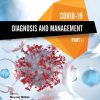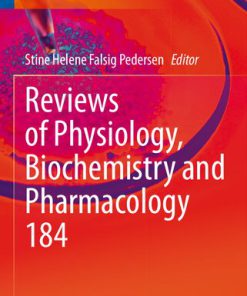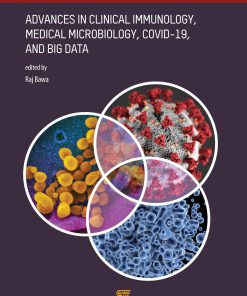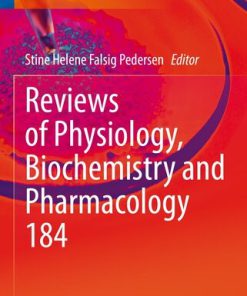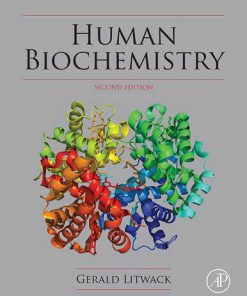Advances in Clinical Immunology Medical Microbiology COVID19 and Big Data 1st Edition by Raj Bawa, Esther H Chang, Gerald F Audette, Anil Diwan, Saadia A Faiz ISBN 9789814877442 9814877441
$50.00 Original price was: $50.00.$25.00Current price is: $25.00.
Advances in Clinical Immunology Medical Microbiology COVID19 and Big Data 1st Edition by Raj Bawa, Esther H Chang, Gerald F Audette, Anil Diwan, Saadia A Faiz – Ebook PDF Instant Download/Delivery: 9789814877442 ,9814877441
Full download Advances in Clinical Immunology Medical Microbiology COVID19 and Big Data 1st Edition after payment
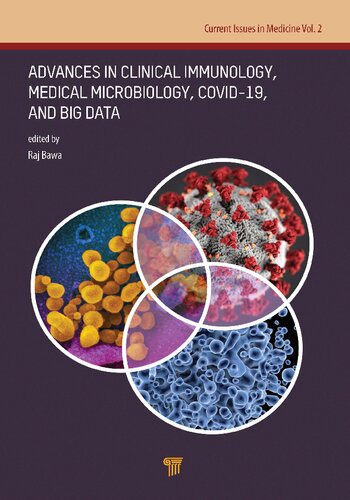
Product details:
ISBN 10: 9814877441
ISBN 13: 9789814877442
Author: Raj Bawa, Esther H Chang, Gerald F Audette, Anil Diwan, Saadia A Faiz
Advances in Clinical Immunology Medical Microbiology COVID19 and Big Data 1st Edition Table of contents:
Chapter 1: SARS-CoV-2 and COVID-19: A Perspective
1.1: Pandemics: A Clear and Present Danger
1.2: The Invader and the Host: A Delicate Dance
1.3: Did SARS-CoV-2 Leak from a Chinese Lab?
1.4: COVID-19 Vaccines: Facts and Fiction
1.5: Will We Ever Achieve Herd Immunity?
1.6: Patents and COVID-19
1.7: Vaccine Passports: Another Bad Government Idea
1.8: COVID-19 Testing
1.9: COVID-19 Convalescent Plasma: Is There a Benefit?
1.10: Looking Back and Moving Forward: Will We Win?
Section 1: Clinical Immunology
Chapter 2: Specific Reactivity of Anti-Citrullinated Protein Antibodies to Citrullinated Peptides Associated with Rheumatoid Arthritis
2.1: Introduction
2.2: Materials and Methods
2.3: Results
2.4: Discussion
Chapter 3: Complement Activation, Immunogenicity, and Immune Suppression as Potential Side Effects of Liposomes
3.1: Introduction
3.2: Types and Features of Immune Responses to Liposomes
3.3: General Causes behind Immune Recognition of Liposomes
3.4: Consequences of Immune Recognition of Liposomes
3.5: Immunogenicity of Liposomes
3.6: Immune Suppression by Liposomes
3.7: Conclusions and Outlook
Chapter 4: Human Clinical Relevance of the Porcine Model of Pseudoallergic Infusion Reactions
4.1: Introduction
4.2: Challenge to the Pig Model’s Human Relevance and Utility in Preclinical Safety Assessment
4.3: Scrutiny of the Challenge to the Pig Model: Facts and Questionable Conclusions
4.4: The Paradox of Healthy Disease Model
4.5: Concordant Symptoms of Pseudoallergy in Pigs and Humans
4.6: The Predictive Power of the Pig Test
4.7: Research Needed to Further Validate the Pig Model
4.8: Problems in the Criticism of the Pig Model
4.9: Conclusions and Future Perspectives
Chapter 5: Myelin Antigens and Antimyelin Antibodies
5.1: Introduction
5.2: Myelin
5.3: EAE and Anti-MBP Antibodies
5.4: Other CNS Myelin Antigens
5.5: PNS Myelin Antigens and EAN
5.6: Significance of Antimyelin Antibodies
5.7: Human Demyelinating Disorders
5.8: Conclusions
Chapter 6: Advances in the Understanding of the Inflammatory Milieu and Its Correlations with Neurological Disorders
6.1: Inflammation and Mechanism in the Body
6.2: Immune Molecules and Proteins of the Inflammatory Milieu
6.3: Neurotrauma and Secondary Neurodegeneration
6.4: Role of Inflammation in Oncogenesis
6.5: Emerging Methods for Diagnosis and Follow-Up
6.6: Future Outlook and Conclusion
Chapter 7: Role of Ligustrum in Allergic Disease
7.1: Introduction
7.2: Ligustrum and Allergic Disease
7.3: Ligustrum Allergens
7.4: Conclusions
Chapter 8: Protective or Detrimental? The Role of Host Immunity in Leishmaniasis
8.1: Introduction
8.2: Clinical Aspects of Leishmaniasis
8.3: The Immunobiology of Leishmaniasis
8.4: Promising Approaches for Drug Development: A Special Focus on the Host
8.5: Vaccines for Leishmaniasis
8.6: Concluding Remarks
Chapter 9: Personalized Nanomedicines for Treatment of Autoimmune Disease
9.1: Introduction
9.2: Systemic Lupus Erythematosus as Representative Autoimmune Disease
9.3: Immune-Mediated Recurrent Pregnancy Loss: Features of Autoimmune Disease
9.4: Therapeutic Modulation of Immune Cells and Their Cytokine Secretion
9.5: Conclusions
Chapter 10: Intracellular Antibody Immunity and Its Applications
10.1: What Is Intracellular Antibody Immunity?
10.2: What Is Tripartite Motif-Containing Protein 21 (TRIM21)?
10.3: What Does TRIM21 Do?
10.4: How Does TRIM21 Work?
10.5: How Can We Exploit TRIM21?
10.6: What Next?
Chapter 11: Maternal Antibody Interference Contributes to Reduced Rotavirus Vaccine Efficacy in Developing Countries
11.1: Rotavirus Vaccine Eficacy Is Reduced in Lower- and Middle-Income Countries
11.2: Evidence Supports matAb Interference as a Mechanism of Reduced RV Vaccine Efficacy
11.3: Establishing a Causal Link between matAb Interference and Low RV Vaccine Efficacy in LMICs and Defining Mechanisms
11.4: Potential Solutions for matAb Interference to RV Vaccines
11.5: Prospects for Overcoming matAb Interference to Infant RV Vaccination
Section 2: Medical Microbiology
Chapter 12: Reflections on 40 Years of AIDS
12.1: Evolving Epidemiology
12.2: Evolving Science and Program
12.3: Evolving Global Health
12.4: Preparing for the Fifth Decade of AIDS
12.5: Lessons from HIV/AIDS and Other Epidemics
12.6: Conclusions
12.7: Addendum
Chapter 13: Formation and Maturation of the Oral Microbiota
Chapter 14: Could the Environment Affect the Mutation of H1N1 Influenza Virus?
14.1: Introduction
14.2: Methods
14.3: Results
14.4: Discussion
14.5: Conclusions
Chapter 15: Current Perspectives in Medical Microbiology
15.1: Continued Poxvirus Research: From Foe to Friend
15.2: Staphylococcus epidermidis—Skin Friend or Foe?
15.3: When Pigs Fly: Pandemic Influenza Enters the 21st Century
15.4: Clostridioides dificile Biofilms: A Mechanism of Persistence in the Gut?
15.5: Cesarean Section and Childhood Infections: Causality for Concern?
15.6: Infectious Hypothesis of Alzheimer Disease
15.7: Insights into Malaria Pathogenesis Gained from Host Metabolomics
15.8: Japanese Encephalitis Virus and Its Mechanisms of Neuroinvasion
15.9: Bringing the Path toward an HIV-1 Vaccine into Focus
15.10: Quorum Sensing across Bacterial and Viral Domains
15.11: Coinfections in Wildlife: Focus on a Neglected Aspect of Infectious Disease Epidemiology
15.12: Isoniazid-Resistant Tuberculosis: A Problem We Can No Longer Ignore
Chapter 16: Bacterial Virulence Plays a Crucial Role in Methicillin-Resistant S. aureus (MRSA) Sepsis
16.1: Introduction
16.2: Results
16.3: Discussion
16.4: Materials and Methods
16.5: Supporting Informaion
Chapter 17: Where Cancer and Bacteria Meet
17.1: Introduction
17.2: Infection and Neoplasia
17.3: Head and Neck Cancers and Bacterial Oral Microbiota
17.4: Bacteria and Bacterial Products in Cancer Treatment
Chapter 18: Fungal Diseases as Neglected Pathogens: A Wake-Up Call to Public Health Officials
18.1: Fungal Diseases: A Real Threat to Public Health
18.2: AIDS and Opportunistic Fungal Diseases: Problem Solved or Current Threat?
18.3: Systemic Mycoses Are Neglected Diseases
18.4: Present and Future Problems: The Unknown
18.5: The Need for Improved Diagnosis of Fungal Infections
18.6: Funding for Research and Innovation in Fungal Diseases
18.7: Perspectives
Chapter 19: Catch the Wave: Metabolomic Analyses in Human Pathogenic Fungi
19.1: Introduction
19.2: What Methods Are Available to Study Metabolomics?
19.3: How to Get the Most Out of Your Metabolomics Data?
19.4: Integrated OMICs Approaches
19.5: What Have We Learned from Metabolomics of Human Pathogenic Fungi to This Date?
19.6: Conclusions and Perspectives
Chapter 20: The Unmet Medical Need for Trypanosoma cruzi-Infected Patients: Monitoring the Disease Status
20.1: Introduction
20.2: Direct Biomarkers
20.3: Indirect Biomarkers
20.4: Conclusion
Chapter 21: Present and Future of Carbapenem-Resistant Enterobacteriaceae Infections
21.1: Introduction
21.2: Mechanisms of Drug Resistance
21.3: Current Resistance Status
21.4: Treatment Options
21.5: Conclusions
Chapter 22: Human Plague: An Old Scourge That Needs New Answers
22.1: Introduction
22.2: Which Hosts and Vectors Should Be Targeted for Human Plague Control?
22.3: What Are the Drivers of Human Plague?
22.4: Which New Diagnostic Tools for Plague Are Needed?
22.5: How Can Plague Surveillance and Case Management Be Improved?
22.6: What Are the Gaps in Knowledge about Y. pestis Biology?
22.7: Discussion
Section 3: Big Data and Artificial Intelligence
Chapter 23: Human Brain/Cloud Interface
23.1: Introduction
23.2: The Human Brain
23.3: The Cloud
23.4: Potential of Current Technologies toward a Brain/Cloud Interface
23.5: Neuralnanorobotic Brain/Cloud Interface
23.6: Human Brain/Cloud Interface Applications
23.7: Conclusion
Chapter 24: Artificial Intelligence in Drug Discovery: What Is New, and What Is Next?
24.1: Designing a Computational Computer Chemist
24.2: The Computer Brain versus the Human Brain for Drug Design
24.3: Harnessing AI for Hit Identification
24.4: Who Holds the IP in AI Drug Discovery?
24.5: The Inevitable Question of Ethics
24.6: Open Source
24.7: So What Is Next for AI in Drug Discovery?
Chapter 25: Now the Future, We See Our Dreams: Artificial Intelligence in Drug Discovery
Chapter 26: Big Data and Artificial Intelligence Meet the COVID-19 Pandemic: Potential Applications and Promises
26.1: The Ongoing COVID-19 Outbreak
26.2: Artificial Intelligence and Big Data
26.3: Short-Term Applications of Artificial Intelligence and Big Data: A Quick and Effective Pandemic Alert
26.4: Short-Term Applications of Artificial Intelligence and Big Data: Tracking and Diagnosing COVID-19 Cases
26.5: Medium-Term Applications of Artificial Intelligence and Big Data: Identifying a Potential Pharmacological Treatment
26.6: Medium-Term Applications of Artificial Intelligence and Big Data: Facilitating the Implementation of Public Health Interventions
26.7: Long-Term Applications of Artificial Intelligence and Big Data: Building Smart, Health, Resilient Cities
26.8: Artificial Intelligence and Big Data for COVID-19: Conclusions and Future Prospects
Chapter 27: Paradigm Shift in Medicinal Chemistry towards Data-Driven Approaches
27.1: Introduction
27.2: Data-Driven Medicinal Chemistry
27.3: Historical Data
27.4: Data Integration
27.5: Data Science
27.6: Machine Learning and Data Mining
27.7: Large-Scale Modeling
27.8: Perspective
Chapter 28: The Importance of Proper Statistical Methods in Developing Robust Predictive Models Using Chemodescriptors and Biodescriptors in the Twenty First Century
28.1: Introduction
28.2: Chemodescriptors: How Much Can Structural Chemistry Alone Help?
28.3: The Advent of Rank Deficiency and Need for Robust Statistical Methodology
28.4: Biodescriptors: Descriptors Derived from Proteomics and DNA/RNA Sequence Data
28.5: Quo Vadimus?
Chapter 29: Fit-for-Purpose?—Challenges and Opportunities for Applications of Blockchain Technology in the Future of Healthcare
29.1: Background
29.2: Using Privacy-Preserving Predictive Models and Blockchain Technology for Electronic Health Records
29.3: Blockchain-Enabled Medical Professional Credentialing and Licensing
29.4: Can We Use Blockchain to Improve Clinical Trial Management?
29.5: Blockchain Technology to Advance Biomedical Research?
29.6: Blockchain Technology Set to Modernize the Pharmaceutical Supply Chain?
29.7: Entering the Genomics Age with the Help of Blockchain Technology
29.8: The Future of the Health Blockchain: Promising Use Cases and the Importance of Technical Standards Setting
Chapter 30: mHealth Approach to Clinics in Rural Settings in Nutrition Counseling
30.1: Introduction
30.2: Materials and Methods
30.3: Results
30.4: Discussion
30.5: Conclusions
Chapter 31: Ten Simple Rules for Engaging with Artificial Intelligence in Biomedicine
31.1: Introduction
31.2: Conclusion
Chapter 32: Five Key Aspects of Metaproteomics as a Tool to Understand Functional Interactions in Host Associated Microbiomes
32.1: What Information Can Be Gained Using Metaproteomics?
32.2: What Are the Prerequisites for Starting a Metaproteomics Study?
32.3: What Does a General Metaproteomics Workflow Look Like?
32.4: How Accessible Is Metaproteomics to the General Scientific Community, and How Much Does It Cost as Compared to Other Meta-Omics Technologies?
32.5: What Do the Data Look Like, and How Can They Be Analyzed?
Section 4: SARS-CoV-2 and COVID-19
Chapter 33: COVID-19: Hundred Questions and Answers for Healthcare Providers and the Public
33.1: FDA, EUA, and COVID-19 Vaccines
33.2: General Information on Safety and Prevention
33.3: Biologics, Human Tissues, and Blood Products
33.4: Development and Use of FDA-approved Drugs for COVID-19
33.5: Diagnostic Testing for SARS-CoV-2
33.6: Pregnancy and COVID-19
33.7: Personal Protective Equipment
33.8: Food Products
33.9: Animals, Pets, and Animal Drug Products
Chapter 34: SARS-CoV-2 Tropism, Entry, Replication, and Propagation: Considerations for Drug Discovery and Development
34.1: Introduction
34.2: Scope/Prior Reviews
34.3: Entry Mechanisms and Proteases
34.4: TMPRSS2 and Furin in Cell Surface Entry
34.5: Lysosomal Cathepsins and Endocytosis
34.6: Cell Line Tropism/Expression
34.7: Nucleotide/Side Import and Conversion
34.8: Primary Cells/Model Systems
34.9: Innate Immune Cells
34.10: Concluding Remarks
Chapter 35: Presence of Antibody-Dependent Cellular Cytotoxicity against SARS-CoV-2 in COVID-19 Plasma
35.1: Introduction
35.2: Materials and Methods
35.3: Results
35.4: Discussion
Chapter 36: Performance of SARS-CoV-2 Serology Tests: Are They Good Enough?
36.1: Introduction
36.2: Materials and Methods
36.3: Results
36.4: Discussion
36.5: Supporting Information
Chapter 37: Forecasting the Novel Coronavirus COVID-19
37.1: Introduction
37.2: Analysis and Forecasting
37.3: Discussion and Conclusion
Chapter 38: Pandemic Responses: Planning to Neutralize SARS-CoV-2 and Prepare for Future Outbreaks
Chapter 39: Pandemic Preparedness and Responses: WHO to Turn to in a Crisis?
Chapter 40: Links between Integrin αvβ3 and COVID-19: Impact on Vascular and Thrombotic Risk
Chapter 41: The Ocular Surface and the Coronavirus Disease 2019: Does a Dual ‘Ocular Route’ Exist?
41.1: Introduction
41.2: Ocular Surface Findings in Case of COVID-19 and Controversial Issues
41.3: Ocular Transmission and the ACE2 Receptors in the Ocular Surface
41.4: Discussion
Chapter 42: Exploring Links between Vitamin D Deficiency and COVID-19
42.1: SARS-CoV-2 Infection and the Cytokine Storm
42.2: Vitamin D and the Host Immune System
42.3: Vitamin D Deficiency and COVID-19
42.4: Conclusions
Chapter 43: Convalescent Serum Therapy for COVID-19: A 19th Century Remedy for a 21st Century Disease
43.1: Bridging the Gap between Now and Then
43.2: Historical Precedent for the Use of Antibody Therapy
43.3: Buying Time with the Help of the Convalescent
43.4: Limitations and Potential Risks
43.5: Future Perspectives
Chapter 44: Preexisting and Inducible Endotoxemia as Crucial Contributors to the Severity of COVID-19 Outcomes
Index
People also search for Advances in Clinical Immunology Medical Microbiology COVID19 and Big Data 1st Edition:
issues in biochemistry
current topics in biochemical research
current issues in biomedical engineering
a current problem in modern medicine is the development
problems in biochemistry
Tags: Raj Bawa, Esther H Chang, Gerald F Audette, Anil Diwan, Saadia A Faiz, Clinical Immunology, Medical Microbiology
You may also like…
Biology and other natural sciences - Genetics
Genetics and Genomics in Medicine, 2nd Edition 2023 Tom Strachan
Medicine - Pharmacology
Reviews of Physiology Biochemistry and Pharmacology 1st Edition Stine Helene Falsig Pedersen
Biology and other natural sciences - Biophysics
Education Studies & Teaching - Special Education
Current Trends and Legal Issues in Special Education 1st Edition David F. Bateman
Medicine - Natural Medicine
Biology and other natural sciences
Medicine - Health-Related Professions
Reviews of Physiology Biochemistry and Pharmacology 1st Edition Stine Helene Falsig Pedersen Ed
Chemistry - Biochemistry

